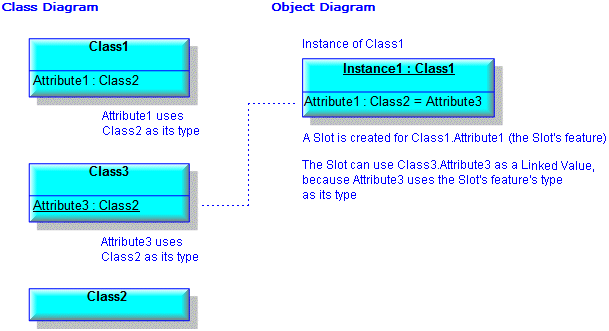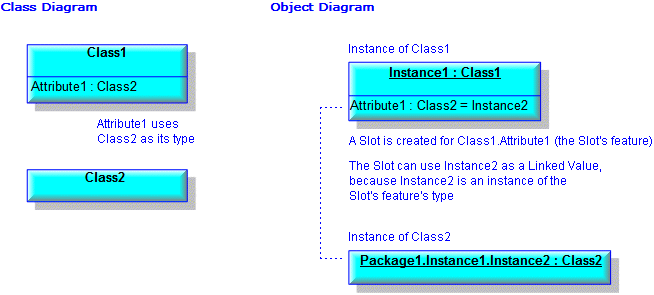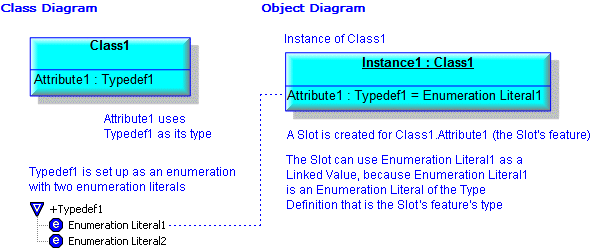Slot (dictionary item)

For automation interface information about a Slot, see
Slot (automation interface).
A Slot corresponds to a single Attribute or Role, and a Slot may include a value.
When you create an Instance for a Class, Data Type, Interface or Signal; Modeler automatically creates a virtual Slot for the following Attributes and Roles:
The Attributes and Roles of the Instance's Class, Data Type, Interface or Signal.
The Attributes and Roles of Classes, Data Types, Interfaces and Signals from which the Instance's Class, Data Type, Interface or Signal inherits through a Generalization relationship.
The Attributes and Roles of template classes from which the Instance's Class, Data Type, Interface or Signal inherits through a bind Dependency.

The virtual Slots are listed on the Slot Values tab of the Instance's Property Pages. Note that you can tell they are virtual Slots because the  Delete Slot button is not enabled when a virtual Slot is selected, and if you click the
Delete Slot button is not enabled when a virtual Slot is selected, and if you click the  Properties button, Modeler opens the Property Pages for the Attribute or Role. In addition, virtual Slots are not shown on Object Diagrams.
Properties button, Modeler opens the Property Pages for the Attribute or Role. In addition, virtual Slots are not shown on Object Diagrams.
 Delete Slot button is not enabled when a virtual Slot is selected, and if you click the
Delete Slot button is not enabled when a virtual Slot is selected, and if you click the  Properties button, Modeler opens the Property Pages for the Attribute or Role. In addition, virtual Slots are not shown on Object Diagrams.
Properties button, Modeler opens the Property Pages for the Attribute or Role. In addition, virtual Slots are not shown on Object Diagrams.You can create a Specification Slot for an instance through the Slot Values tab of an Instance's Property Pages.
When selecting items to be Linked Values, only valid items can be selected.
For a Slot that has been created for an Attribute or Role, Linked Values can be valid Attributes, Instances and Enumeration Literals. In addition, a Specification Slot's Linked Values can include valid States:
Attributes can be used as Linked Values under the following conditions:
1. The Attribute is typed by the Class, Data Type, Interface or Signal that is the Slot's feature's type.
2. The Attribute is Read-only
3. The Attribute has On Class storage.
Note that if the Slot's feature is untyped, that Slot can use as Linked Values any Attribute that is Read-only with On Class storage.
For example:

Instances can be used as Linked Values when they are Instances of the Slot's feature's type.
For example:

Enumeration Literals can be used as Linked Values when they are owned by the Type Definition that is the Slot's feature's type.
For example:

States can be used as Linked Values when those States are owned by the Class, Interface or Signal that is the Slot's feature's type.
Slots are not shown in the Modeler panes.
The following sections provide information about how a Slot is used in the model. For more information about a property, item, model part or diagram, click it.
Properties
Text Value (Scalar Value through the automation interface)
Linked Values (Value association through the automation interface)
Owned by
Owns
None.
Defined in these parts of the model
Shown on these diagrams
For information about how the View Options affect the presentation of Slots, see the following topics:
Can be linked to these dictionary items
Through Linked Values, a Slot can be linked to items of the following type:

 Instance
Instance Instance Model
Instance Model Communication Diagram
Communication Diagram Object Diagram
Object Diagram Sequence Diagram
Sequence Diagram Variant Diagram
Variant Diagram Attribute
Attribute Enumeration Literal
Enumeration Literal